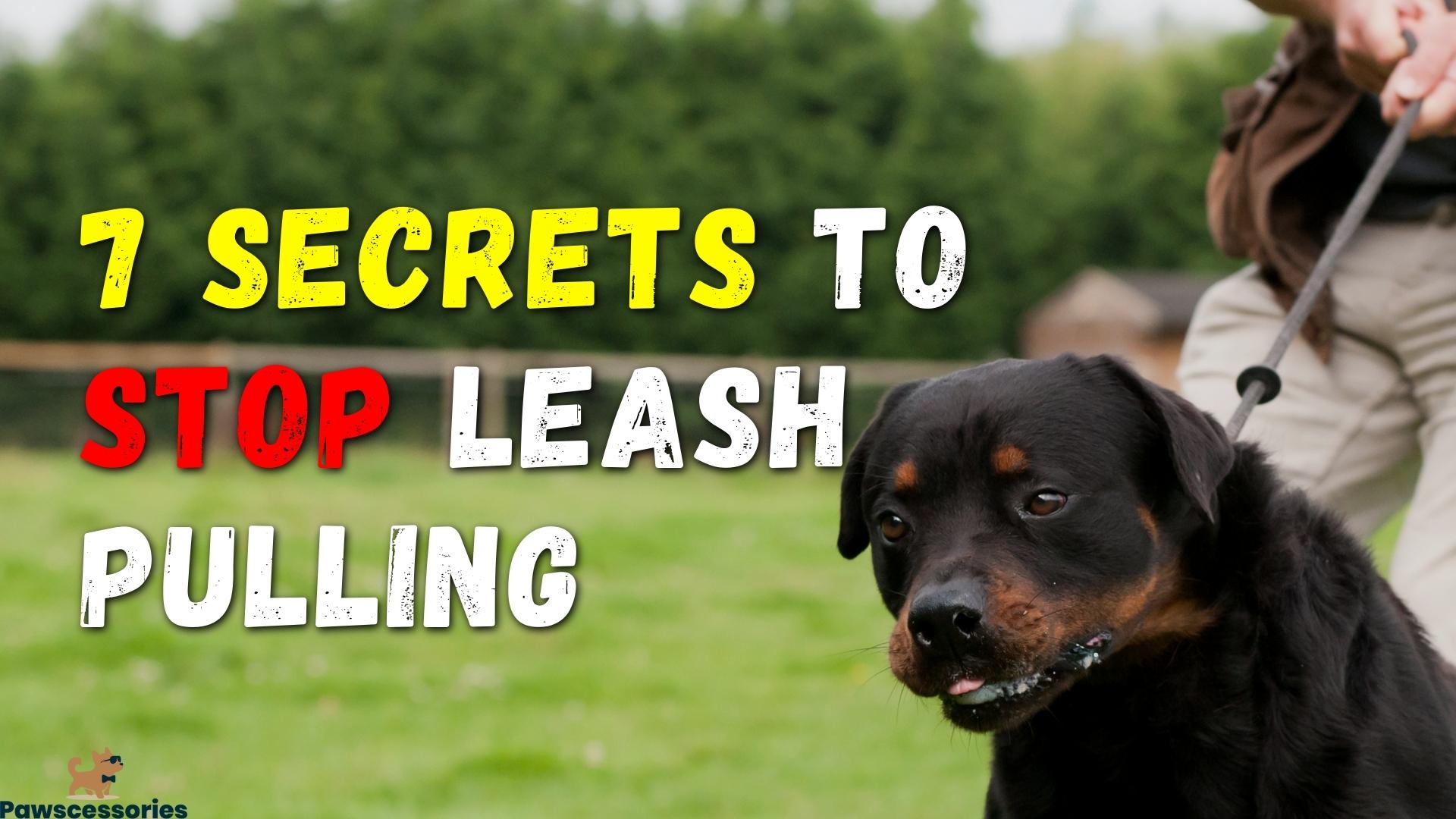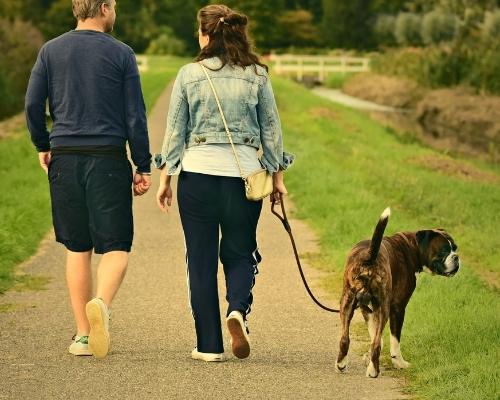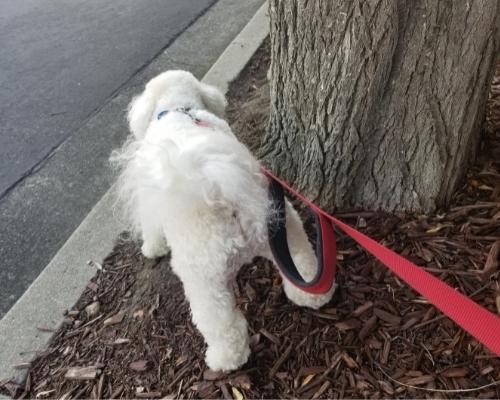Pawscessories is reader-supported. When you buy via links on our site, we may earn an affiliate commission at no cost to you.
Learn more.
One of the most common problems dog owners face is being pulled around by their pup while out for a walk.
Leash pulling can be extremely frustrating to deal with and takes much of the fun out of walking your dog.
So how can you stop leash pulling and bring back the joy of walking your pup?
In this post we reveal:
- 7 simple secrets to completely stop leash pulling (#2 walks through specific training steps)
- The dangers associated with leash pulling and using the wrong tools
- Simple steps you can take to get your pup to walk beside you (and not pulling ahead in front) in just 10 minutes per day
Let’s dive in.
Table of Contents

Why Do Dogs Pull On Leash?
Before we get into how to stop your dog from pulling on leash, it’s important to understand WHY dogs pull on the leash in the first place. Dogs are natural explorers and love to sniff everything they come across while out on a walk. This is how they learn about their environment and take in all the new sights and smells.
Unfortunately, this natural instinct to pull on the leash can often result in owners feeling frustrated and helpless. But there are actually a few reasons why dogs pull on leash:
They’re Excited
Dogs will often pull on leash because they’re excited to be out and about exploring. This is especially common in puppies who haven’t learned how to properly walk on a leash yet. This can also happen when dogs see other people, or animals.
They’re Curious
Dogs are curious by nature and love to sniff everything they come across while out on a walk. This can often result in them pulling ahead to get a better smell of something.
They Want To Go Faster
Sometimes dogs will pull on the leash because they want to go faster than you’re walking. This is often the case with dogs who are full of energy and love to run around.
They’ve Been Unintentionally Trained
Oftentimes, dogs will pull on the leash because they’ve been unintentionally trained to do so. If you allow your dog to pull on the leash while walking, they will quickly learn that this is how they should walk. The tension on the leash from them pulling becomes a cue for them to continue walking.
So know that we know why some dogs pull how do you stop your dog from pulling on the leash?
7 Secrets To Stop Your Dogs Leash Pulling (Simple Steps)
By the end of this post you’ll know exactly how to get your pup to stay by your side during your walks.
As a quick overview here is how to stop your dog from pulling on the leash in 7 steps:
- Get The Right Tools & Use Them Properly
- Train In Areas With No Distractions
- Properly Teach Loose Leash Walking
- Don’t Reinforce Bad Behavior
- Let Your Dog Get Some Smells In
- Know Your Dogs Pace
- Set Achievable Challenges When Training
1) Get The Right Tools & Use Them Properly
There are a few options when it comes to tools that can help reduce your dog’s leash pulling.
Collars
When it comes to collars for dog pulling you’ll want to use a plain, flat collar.
One that’s fitted and allows you get roughly 2 fingers between the collar and your dog’s neck.
While you don’t want it to be too tight, you want to make sure it’s snug enough that it can’t be slipped over your pup’s head.
If your dog pulls really hard, until they cough or have noisy breathing, or they can overpower you when they pull, a basic collar may not be the right choice.
One of the best choices for a dog that pulls is a head collar / gentle lead collar. A lead collar can usually stop leash pulling in 5 minutes after your dog realizes how uncomfortable it is for them to pull while wearing one.
These types of collars give added control and prevent dogs from having the leverage necessary to pull. Just be carefully at frist since most dogs are not accustomed to things on their face.
Here’s the best head collar on amazon: PetSafe Gentle Leader Headcollar
What about ‘training’ collars?
Slip, choke, prong, and electric collars all rely on pain to stop a dog from pulling.
Although they can be effective in the short term, there are a few difficulties you may face when using them.
First off, the pain needs to hurt or shock your dog enough to stop them from pulling.
And some dogs won’t even stop unless the pain gets severe enough. The issue here is you’re now training your dog to be accustomed to pain.
And over time your dog will begin adapting to the pain, making it harder to get them to listen unless you can increase the pain. For example, at my family’s clinic there was an older rottweiler that was brought to the clinic.
This kind older lady was taking care of him but complained about not being strong enough to control him anymore.
She had been using a prong collar for a while and the dog had developed thick skin around his neck.
At first this worked to control the dog but over time the dog got so accustomed to the pressure around his neck it stopped working.
It no longer caused any discomfort to the dog.
Which means it no longer worked to stop him from pulling.
The point here is using pain as a method for controlling dogs and preventing leash pulling doesn’t last.
It’s better to avoid relying on pain to control your dog and instead focus on proper techniques to adjust their behavior.
Leashes
So what are the best leashes for dogs that pull?
Choose a leash that is 6-10’ in length and comfortable for your hand.
Avoid retractable leashes, which extend every time your dog pulls. These leashes promote pulling even more.
You may even want to grab one of the leashes that has the extra handle further down the leash for better control.
This is really helpful if you have a large dog like myself.
I’ve found it especially great for certain situations where we want to have more control if we need it.
Here are my top rated leashes after using many different ones:
Joytale Reflective Dog Leash
Paw Lifestyles Heavy Duty Dog Leash (2 handles, ideal for bigger dogs)
Harnesses

An H-style or Y-style harness can be a great tool to help prevent leash pulling.
Now it’s important to note that this only applies to harnesses with a front-attachment.
When a leash is attached to the front side of a harness it allows for more control. This can reduce 70% of dog pulling on its own in the 5 minutes it takes to put it on.
It basically makes pulling uncomfortable. However, dog can adapt to this as well and can continue to pull regardless, so you will still want to pair it with proper training.
After writing articles reviewing 100s of different harnesses, the Rabbitgoo No-Pull Dog Harness was by far the best to reduce dogs pulling on leash.
High Value Treats
One of the most important tools when training your dog on leash is the treats you use.
Treats are the rewards your dog gets for listening.
If they don’t feel like the treats you’re offering are worth it for what you’re asking them to do, they won’t do it.
So make sure when choosing treats that you get high value treats.
Like cooked chicken, for example.
However, it’s completely dependent on your dog as some pups are completely happy with kibble as a treat.
*Note: these tools can help when dealing with your dogs leash pulling but nothing can replace proper training. Read on for the exact ways you can use these tools combined with training to stop leash pulling for good.
You may want to consider enrolling in SpiritDog Training’s Loose Leash Walking Bundle — After trying dozens of different programs to help with leash walking this is by far the best.
She has over 32,226 students across her trainings with 100% satisfaction and it’s designed for just 10 minutes of training per day.
You get lifetime access to professional dog trainers, on demand step by step video training, instructional PDFs, progress tracking, all from the comfort of your home.
You can try out SpiritDog’s Loose Leash Walking Bundle at no risk with their 60-day money back guarantee.
2) Train In Areas With No Distractions
When your dog is pulling on their leash and nothing seems to be working it’s time to go back to the basics.
Instead of continuing to walk your dog outside, take them back inside to train distraction free.
This will make sure there’s nothing that will distract your dog and keep their attention on you.
3) Properly Teach Loose Leash Walking

Rather than just talk about all the things people do wrong, here’s a guide on how to properly teach your dog to heel and stay by your side on walks (and stop leash pulling).
You will need: treats, leash, collar (or front-attachment harness).
- First and foremost, you never want your leash to be tight during training. You always want the leash to be loose.
It should almost form a perfect ‘J’ shape when you hold it.
- Next, as you’re showing them how to walk beside you, you will want to set up trigger words, actions, or phrases that lets your dog know they’re about to get a reward.
Some people use clickers, words like “yes”, or they cluck their tongue. Whatever method you choose, anytime they follow instructions, make a sound and give them their reward.
- At first, you can use treats to hold out in front of your dog while you walk. This is simply guiding them to walk forward beside you. Not in front of you.
Start inside to avoid them getting distracted, pulling, and running the training session.
Don’t give them the treat right away though, simply hold it in front of their nose, start walking a few steps, then make your trigger sound and give them the treat.
This is the basic strategy you’ll need to repeat over and over until they understand how to walk beside you.
You can throw in some stops as well to teach them to sit down beside you.
Depending on your dog you may need to replace lower value treats with higher valued treats such as little pieces of chicken or meat.
Once your dog has that down pat it’s time to deal with the pulling and reactivity when outside of your house with many possible distractions.
Whenever your pup pulls or bolts off, stop walking and hold a treat by your side. Make sure it’s clearly visible.
When done right and with the right high-value treat, your dog should return to your side to get the treat.
When they do, say your command word like “yes” or “heel”, then praise and reward them.
As you continue to do this, start to hide the treats more so they begin to listen without the need of seeing a treat.
If things are improving keep going, if they’re getting worse, go back a step.
For additional help with leash training, you might want to consider an online leash training program. They can provide more guidance and individualized help depending on your situation.
4) Don’t Reinforce Bad Behavior
Be patient and tolerant of their mistakes.
If you get mad and frustrated it’ll often lead to yelling, yanking your dog when they pull, or just giving up and following them.
These things cause the bad habits to become reinforced and only makes things worse.
Stick to positive reinforcement and avoid punishment.
Only reward your dog when they behave the way you want and when they misbehave, stay calm and patient.
5) Let Your Dog Get Some Smells In

You want to make walking a fun, enjoyable experience for your pup.
Dogs like to smell trees, bushes, pee in a variety of places, and check out other dogs.
It’s fun for them and a dog’s walk is usually one of the best parts of their day. You want to let them enjoy it a little!
Now, you don’t have to always let them walk up to every pole, bush, fire hydrant, etc. But be sure to let them get in a few here and there.
By letting your dog get some smells in it will actually help reduce leash pulling.
Instead of your dog having to fight you to get their smell in, they know they can calmly go over to an interesting smell.
6) Know Your Dogs Pace
Some dogs pull on the leash because their owners are walking too slow.
Knowing how fast or slow to walk when training will vary depending on your dog.
Higher energy dogs will likely benefit from a faster pace than other dogs.
If you set a pace that’s too fast, your dog might jump up or get overly excited.
If you walk too slowly, you will make things a lot harder for your dog, and pulling will likely occur.
A good rule of thumb is to walk like you’re late for something.
You’ll know when you’re walking at the right pace when your dog has some excitement but not too much where they’re trying to walk way ahead of you.
You may want to consider enrolling in SpiritDog Training’s Loose Leash Walking Bundle — After trying dozens of different programs to help with leash walking this is by far the best.
She has over 32,226 students across her trainings with 100% satisfaction and it’s designed for just 10 minutes of training per day.
You get lifetime access to professional dog trainers, on demand step by step video training, instructional PDFs, progress tracking, all from the comfort of your home.
You can try out SpiritDog’s Loose Leash Walking Bundle at no risk with their 60-day money back guarantee.
7) Set Achievable Challenges When Training
One common mistake people make when training their dogs to loose leash walk is setting goals that are far too challenging.
You want your dog to feel like they’re doing well, so set them up for success.
Pick a short distance for them to walk that you think they can do and be well behaved without problem.
A good rule of thumb is to start with about 10-15 feet.
Then, make sure you’re in an environment with as few distractions as possible when starting their leash training outside.
This could be a parking lot, your driveway, a park, etc. It doesn’t matter so long as you have an area with limited distractions. You want to make this as easy as you can for them.
Next, you want to set the duration of your leash training sessions to a few minutes to start. This primarily depends on your dog’s age.
The younger the shorter the attention span, so the shorter the session should be.
This way you can maximize your training in this time and end the training on a win.
This is extremely important for keeping your pup motivated.
When you set achievable goals for your pup and let them get small wins it only encourages them to keep improving.
Which helps them become better walks sooner rather than later.
How To Stop A Dog From Pulling When Seeing Another Dog
When a dog is leash pulling due to other dogs or animals, this is usually and indication of reactivity. The best way to handle reactivity on the leash is by desensitizing them to their trigger.
In this case the trigger is other dogs, so in order to reduce pulling your dog needs to become comfortable seeing other dogs on walks without freaking out.
Here are 7 steps to train a reactive dog:
- Identify Reactivity Triggers (In this case, other dogs)
- Desensitize Them To Their Triggers
- Set Up A Plan And Routine
- Get The Proper Equipment
- Understand Their Body Language Cues
- Control Their Environment
- Never Respond With Anger Or Frustration
- Get Professional Help
For more details on each of these steps check out our full guide on training a reactive dog.
Not All Methods Will Work Perfectly For Every Dog
So your dog still pulls on leash after you’ve tried everything to stop it. Well unfortunately not all methods work perfectly for every dog.
You may have to try a few different things or mix and match what you’ve learned to find something that works. Most of the time when a dog continues to pull on the leash even after training, it’s because they’re not getting enough exercise, have a reactivity issue, or have been improperly trained.
Dog reactivity is a common issue and can be difficult to deal with. It’s important to get help from a professional if your dog is reactive on leash. This type of leash pulling needs to be handled different.
If a dog is pulling on leash because they are constantly reacting to things, then the issue is reactivity, not simply leash pulling.
Final Thoughts
We hope this article has given you some helpful tips on how to stop dog from pulling on leash. Remember, it will take time and patience to train your dog to walk nicely on a leash. But with consistency and positive reinforcement, you can surely achieve success.
Remember, dog pulling on leash is a common issue and there are many different ways to handle it. If one method doesn’t work, don’t get discouraged. Just try something else until you find what works best for you and your dog.
If you get stuck or need some extra help, you can always consult a professional dog trainer. They will be able to help you troubleshoot the issue and come up with a plan that works best for you and your dog.
